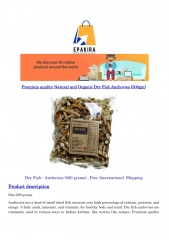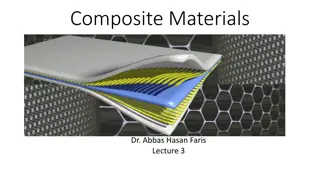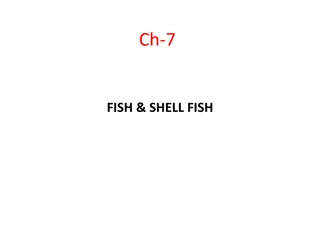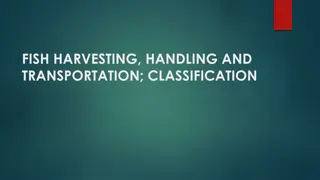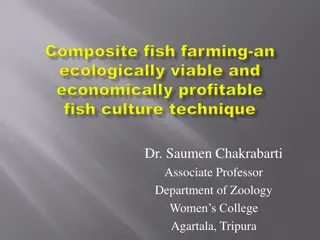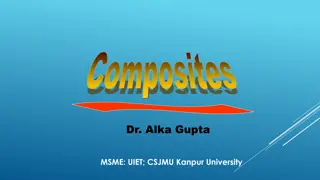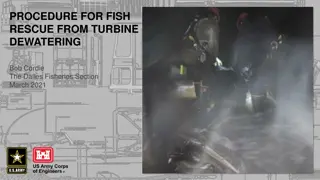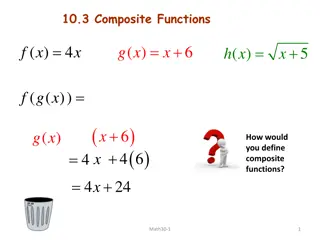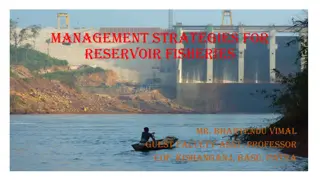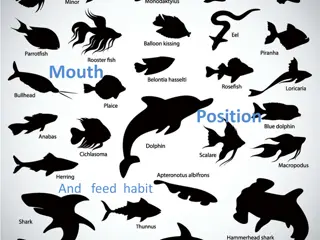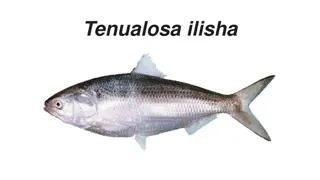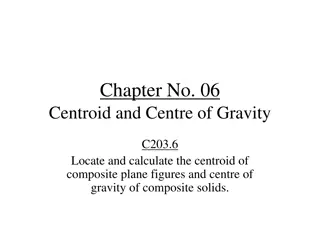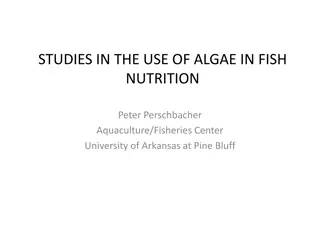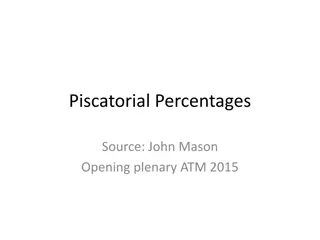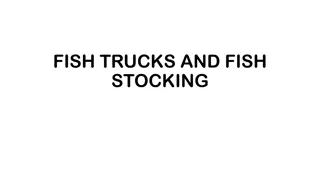Understanding Composite Fish Culture for Increased Productivity
Composite fish culture involves stocking different fish species with varying feeding habits in the same pond to optimize space and resources. This method allows for the utilization of all niches in the pond, leading to assured production and easy management. The article covers the species involved, feeding habits, potential for aquaculture, technical parameters, and eligibility for borrowers.
Download Presentation

Please find below an Image/Link to download the presentation.
The content on the website is provided AS IS for your information and personal use only. It may not be sold, licensed, or shared on other websites without obtaining consent from the author. Download presentation by click this link. If you encounter any issues during the download, it is possible that the publisher has removed the file from their server.
E N D
Presentation Transcript
DR. SARBOJIT THAOSEN HAFLONG GOVT. COLLEGE
Introduction Stocking of Cultivable fishes of different species which differ in feeding habits in the same pond is called composite fish culture. Many species in one pond Utilization of all niches Developed from monoculture Six species combination good Culture period 6 8 months Suitable for all areas Easy to do and assured production
1. Fish species involved in composite fish culture Depending on the compatibility and type of feeding habits of the fishes The following types of fishes of Indian as well as Exotic varieties have been identified and recommended for culture in the composite fish culture technology
Species feeding habit feeding zone Indian Major Carp Catlacatla Zooplankton feeder Surface feeder L. rohita Omnivorous Column feeder C. mrigal Detritivorous Bottom feeder Exotic Carps Silver carp Phytoplankton feeder Surface feeder Grass carp Herbivorous Surface, column and marginal areas Common carp Detritivorous/ omnivorous Bottom feeder
2. Potential The area under tanks and ponds available for worm fersh water aquaculture in estimated to be 2.41 million ha. In addition 0.1.31 million ha. Of swamps, beels, etc. Lowlaying water logged area not good for agriculture. Inland fish production of 4.7lakh tonnesaround 80% is contributed by the culture sector. Average productivity in ponds: 2500kg/ha/year. Only 15% of the potential area of tank and ponds available is developed
3. Technical parameters i. Includes site selection ii. Items of development iii. Pre and post stocking operations iv. Stocking density v. Fertilization vi. Feeding
4. Margin The margin money may be considered @5, 10 & 15% for small Medium and large farmer respectively and 25% for companies and partnership firms.
5. Eligible borrowers A. An Individual B. A company C. A partnership firm D. A co-operative society. E. A group of fish farmers.
Technical Parameters Technical parameters that need to be considered for composite Fish Culture are as follows: 1. Selection of Pond The main criteria to be kept in mind is that the soil should be water ertentive, adequate supply of water is assured and that the pond is not in flood prone area. The eligible items of pond development are as : Desilting of existing pond Deepening of shallow water. Excavation of new ponds. Impoundment of marginal areas of water bodies, Constructionof inlets / outlets, Any other item like civil structures, watchmen sheds, pump sets water supply arrangements / electricity supply arrangements etc. a) b) c) d) e) f)
2. Pond Management Pond management plays a very important role in fish farming before and after the stocking of fish seed Various measures that are required to be undertaken in pre and post stocking practices are tabulated below a) Prestocking i. Removal of weeds by Manual/Mechanical or through Chemical means. ii. Removal of unwanted and predatory fishes , other animals by repeated netting or using mahuaoilcake @ 2500 kg/ha, or by sun drying the pond bed. iii. Liming The soil / tanks which are acidic in nature are less productive than alkaling ponds. a) increaseases pH b) Acts as buffer and avoids fluctuations of pH c) Increases the resistance of soil tom parasites d) Its toxic effect kills the parasites. e) It hastens organic decompiosition.
iv.Fertilization ? Mannuring Fertilization of the pond is an important means for intensifying fish culture by increasing the natural productivity of the pond. The fertilization svhedule has to be prepared after studying the quality of the pond soil. Suitably modified depending on the growth of fish. Available food reserve in the pond , Physicochemical conditions of the pond and climatic conditions
Inorganic Fertiliser Application (kg/ha/month) Soil fertility status Ammonium sulphate Urea 1. Nitrogen (mg/100 g soil) 70 30 i) High 90 40 ii. Medium (26 - 50) 140 60 iii. Low (upto 25) 2. Phosphorus (mg/100 gm soil) Single super phosphate Triple super phosphate i) High (7 - 12) 40 15 ii. Medium (4 - 6) 50 20 iii. Low (upto 3) 70 30
B.) STOCKING The pond will be ready after 25 days of application of fertilizers. Fingerlings of 50 100 gm size (approx)should be used for stocking @ 5000 nos. per ha. Fingerlings and rearing for 10 12 months. Depending on the availability of seed and market conditions, Stocking can be of 3, 4 or 6 species combination in the following ratio:- speciesw 3species 4species 5species Catla 4.0 3.0 1.5 Rohu 3.0 3.0 2.0 Mrigal - 2.0 1.5 Grass carp - - 1.5 Common carp 2.0 2.0
C. POST STOCKING a.) Supplementary feeding Food is available naturally in the pond. Fishes can be fed with a mixtyreof rice bran and oilcakes in the ratio 4:1 The recommended feedingrate is 5 6 % body weight upto 500 gm size of fish. Then reduce to 3.5% body weight from 500 1000gm size. The feeding is supplementary in nature. Feeding materials a) Mahuaoil cake b)Groundnut oil cake
b) Manuring Organic manuring be done in monthly instalments @ 100 kg/ha. Inorganic fertilization maybe done at monthly intervals alternating with organic manuring. The monthly rate of fertilization will depend on pond productivity and the growth of the fishes. c) Harvesting Harvesting is generally done at the end of year, when the fishes attain avg. weight of 800 gm to 1.25 kg Proper management a production of 4 to 5 tons/ha can be obtained in a year. Harvesting is done by partial dewatering and repeated netting. Harvesting equipments 1. Nets 2. Traps Etc.
3) Vertical expansion of fish culture Stocking of advanced fingerlings / yearlings by stunning the growth of fish seed during first year. Heavy stocking and multiple harvesting after the fishes attain a size of 500 gms. Multiple stocking and multiple harveating , use of aerators, Integrated fish farming with animal husbandaryactivities like diary, poultry, piggery or duckery to get daily organic manuring to pond thus increasing its fertility. Production of fish to 7 to 10 tonnes / ha/ year. THANK YOU


